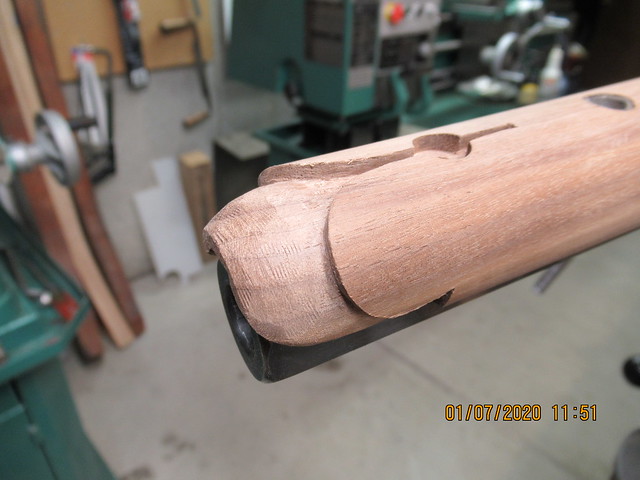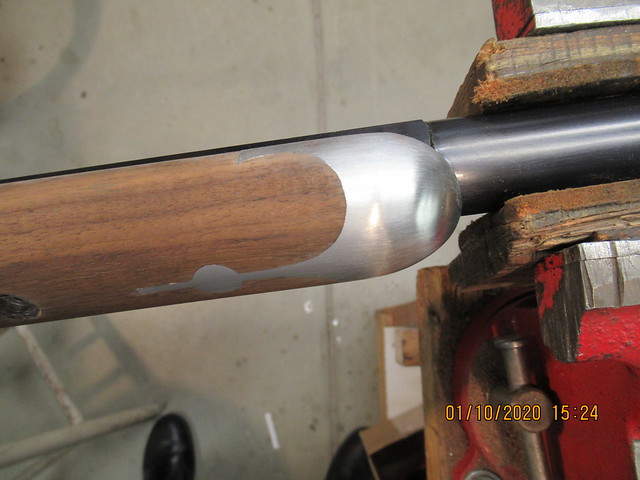Have read a few threads/posts concerning making pewter inlays and castings, even using lead free solder. My question is how is this done? Cut the inlay then pour in melted pewter/solder? Make a casting then fit it? How does one deal with a curved surface when pouring melted pewter/solder?
-
Friends, our 2nd Amendment rights are always under attack and the NRA has been a constant for decades in helping fight that fight.
We have partnered with the NRA to offer you a discount on membership and Muzzleloading Forum gets a small percentage too of each membership, so you are supporting both the NRA and us.
Use this link to sign up please; https://membership.nra.org/recruiters/join/XR045103
You are using an out of date browser. It may not display this or other websites correctly.
You should upgrade or use an alternative browser.
You should upgrade or use an alternative browser.
Pewter Inlay Question
- Thread starter kje54
- Start date

Help Support Muzzleloading Forum:
This site may earn a commission from merchant affiliate
links, including eBay, Amazon, and others.
user 34300
54 Cal.
- Joined
- Nov 25, 2019
- Messages
- 1,743
- Reaction score
- 2,124
I have made several pewter nosecaps. Basically you make a mold right on the gun and fill it with melted pewter. IT is then shaped to final dimensions later.
Pewter is not normally used for inlays. You cut them out of sheet stock and inlet them. There are cast thumb pieces but not normally pewter.
Linotype alloy makes nice nosecaps. It is very low melting temp and casts the best of all lead alloys.
Pewter is not normally used for inlays. You cut them out of sheet stock and inlet them. There are cast thumb pieces but not normally pewter.
Linotype alloy makes nice nosecaps. It is very low melting temp and casts the best of all lead alloys.
Okay, imagine I know nothing at all about this process, actually don't imagine, I know absolutely nothing about this process so think like a complete noob.I have made several pewter nosecaps. Basically you make a mold right on the gun and fill it with melted pewter. IT is then shaped to final dimensions later.
Pewter is not normally used for inlays. You cut them out of sheet stock and inlet them. There are cast thumb pieces but not normally pewter.
Linotype alloy makes nice nosecaps. It is very low melting temp and casts the best of all lead alloys.
GANGGREEN
45 Cal.
Not to change the subject, but I have an upcoming project and wish to pour a pewter nose cap. Can anyone tell me what the process is to dye the pewter? I think I've heard that there's a powder product that can be used, but maybe it's even easier than that and there are household items that can be used. Anyone?
You can make a little dike around the inlay area with Plummer's putty, under cutting the inlay will make it hold fast. The more careful with the pour the easier the finishing, when cool, file and sand it down to the wood surface.
Robby
Robby
- Joined
- Apr 9, 2012
- Messages
- 1,934
- Reaction score
- 3,733
Okay. Now you have my interest. Does the heat from melted pewter not damage the wood? Polecat
Thank you. Now assuming I want to make a nose cap or an inlay on the top of the comb, say decoratively extending the top part of the butt plate, how would I go about that? Sand cast then fit? And how does one sand cast?You can make a little dike around the inlay area with Plummer's putty, under cutting the inlay will make it hold fast. The more careful with the pour the easier the finishing, when cool, file and sand it down to the wood surface.
Robby
Phil Coffins
69 Cal.
It’s easy, carve the shape in the finished stock. Under cuts and holes in the pattern give the casting a grip. Then form a dam with tablet backing and pieces of wood taped onto the stock. Warming the barrel in this example helps. Melt the metal to just fluid and pour it in. It won’t burn the wood and the form can be taken off in a couple of minutes. File and sand to finish.
 IMG_0480 by Oliver Sudden, on Flickr
IMG_0480 by Oliver Sudden, on Flickr
 IMG_0484 by Oliver Sudden, on Flickr
IMG_0484 by Oliver Sudden, on Flickr
 IMG_0480 by Oliver Sudden, on Flickr
IMG_0480 by Oliver Sudden, on Flickr IMG_0484 by Oliver Sudden, on Flickr
IMG_0484 by Oliver Sudden, on FlickrOkay. Now what do you mean by "tablet backing"?It’s easy, carve the shape in the finished stock. Under cuts and holes in the pattern give the casting a grip. Then form a dam with tablet backing and pieces of wood taped onto the stock. Warming the barrel in this example helps. Melt the metal to just fluid and pour it in. It won’t burn the wood and the form can be taken off in a couple of minutes. File and sand to finish.
IMG_0480 by Oliver Sudden, on Flickr
IMG_0484 by Oliver Sudden, on Flickr
Phil Coffins
69 Cal.
The thin card board that has paper sheet for notes not it, like a legal pad or such.
this tip was poured with 95% tin 5% antimony, close to be being pewter.
this tip was poured with 95% tin 5% antimony, close to be being pewter.
That's what I thought you meant but I needed to be absolutely sure. Do you use pewter or linotype alloy?The thin card board that has paper sheet for notes not it, like a legal pad or such.
GANGGREEN
45 Cal.
I used manila folder material the last time I did it. Another question for myself and for others, I've always heard that the barrel could be heated and should be in the stock when you make your pour, correct? If so, I presume that also requires you to lay some protective material under the barrel to prevent the molten pewter from finding it as well.
Phil Coffins
69 Cal.
I heat the barrel to uncomfortably warm then place it in the stock. I don’t use anything other then a close fit and the metal stops right there. The metal doesn’t get any thing on it but maybe a steamy mark that wipes off. For melting I use a tin can or ladle heated with a propane torch.
GANGGREEN
45 Cal.
I've only done it twice, but I just used a Lee pot that guys use for melting and casting lead round balls. Pewter melts at a fairly low temp and yeah, I'd presume that you could do it on the stove, just be careful to avoid water or anything else combustible. I'd personally feel better doing it outside or a larger open area indoors (I use my shop, which is huge, but I clear a large area to work in and have a fire extinguisher handy and nearby).
I was wondering because I've seen Lodge cast iron melting pots and ladles. Don't know which would be better to use, cast iron or something else.I've only done it twice, but I just used a Lee pot that guys use for melting and casting lead round balls. Pewter melts at a fairly low temp and yeah, I'd presume that you could do it on the stove, just be careful to avoid water or anything else combustible. I'd personally feel better doing it outside or a larger open area indoors (I use my shop, which is huge, but I clear a large area to work in and have a fire extinguisher handy and nearby).
Never cast a nosecap but have done other stuff successfully on a campfire.
You can use a metal cup to melt.
For pewter i used old mugs from the thrift shop.
The metal should be fluxed and will melt at a much lower temp than lead such that wax will pool but not ignite on top of the melt.
You can use a metal cup to melt.
For pewter i used old mugs from the thrift shop.
The metal should be fluxed and will melt at a much lower temp than lead such that wax will pool but not ignite on top of the melt.
How do you flux it?Never cast a nosecap but have done other stuff successfully on a campfire.
You can use a metal cup to melt.
For pewter i used old mugs from the thrift shop.
The metal should be fluxed and will melt at a much lower temp than lead such that wax will pool but not ignite on top of the melt.
I used candle wax stirred through.
Suggest ypu try a few test pieces before anything else.
Now if you are going to cast then inlay i have a couple of tricks.
To create a mold easily for an existing part press the part between two cuttlefish bones. I uced to file location notches in the sides once they were pressed together then create a sprue.
Else using plaster of paris you can make a two piece mold easily. Just need to make sure it is dry before use. Straight plaster is good for about a dozen casts. Addind sand increases that number.
For sand casting you use fine sand and moisten it with water or oil just to the point it will stick together. Ypu press your part into this, cut your sprue and go for it.
Suggest ypu try a few test pieces before anything else.
Now if you are going to cast then inlay i have a couple of tricks.
To create a mold easily for an existing part press the part between two cuttlefish bones. I uced to file location notches in the sides once they were pressed together then create a sprue.
Else using plaster of paris you can make a two piece mold easily. Just need to make sure it is dry before use. Straight plaster is good for about a dozen casts. Addind sand increases that number.
For sand casting you use fine sand and moisten it with water or oil just to the point it will stick together. Ypu press your part into this, cut your sprue and go for it.
user 34300
54 Cal.
- Joined
- Nov 25, 2019
- Messages
- 1,743
- Reaction score
- 2,124
Heavy duty aluminum foil and electrical tape is my go to for making nose cap forms.
Similar threads
- Replies
- 18
- Views
- 1K
SOLD - Pending funds
Half stock percussion 50 ca PRICE DROP
- Replies
- 6
- Views
- 886
- Replies
- 4
- Views
- 476



